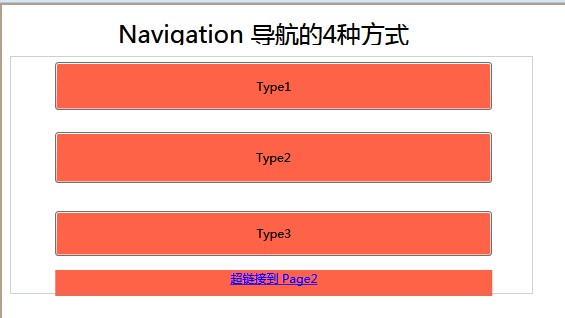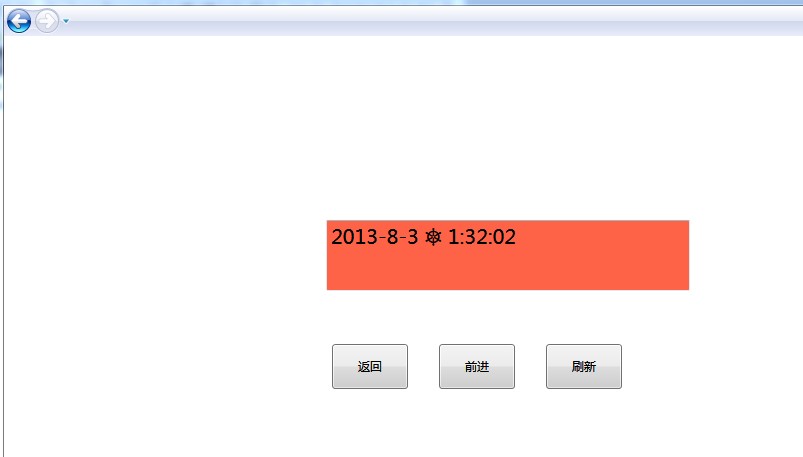WPF实现导航的几种方式
下面是展示的是几种导航方式:

我们来具体看下xaml文件
<Page x:Class="WPF实现Navigation.Page1" xmlns="http://schemas.microsoft.com/winfx/2006/xaml/presentation" xmlns:x="http://schemas.microsoft.com/winfx/2006/xaml" xmlns:mc="http://schemas.openxmlformats.org/markup-compatibility/2006" xmlns:d="http://schemas.microsoft.com/expression/blend/2008" mc:Ignorable="d" d:DesignHeight="336" d:DesignWidth="626" Title="Page1"> <Grid Width="619" Height="328"> <Canvas Margin="10,53,86,37" Name="grid1"> <Button Background="Tomato" Canvas.Left="9.26" Canvas.Top="-107" Click="button1_Click" Content="Type1" Height="48" Margin="36,113,27,0" Name="button1" VerticalAlignment="Top" Width="437" /> <Button Background="Tomato" Canvas.Left="9" Canvas.Top="-74" Click="button2_Click" Content="Type2" Height="51" Margin="36,150,27,127" Name="button2" VerticalAlignment="Top" Width="436.74" /> <Button Background="Tomato" Canvas.Left="9.26" Canvas.Top="155" Click="button3_Click" Content="Type3" Height="45" Margin="36,0,27,88" Name="button3" VerticalAlignment="Bottom" Width="437" /> <TextBlock Background="Tomato" Canvas.Left="45.26" Canvas.Top="214" Height="26" Text="Type4" TextAlignment="Center" Width="437"><Hyperlink NavigateUri="Page2.xaml">超链接到 Page2</Hyperlink></TextBlock> </Canvas> <Label Content="Navigation 导航的4种方式" FontSize="24" Height="37" Margin="113,10,0,0" Name="label1" VerticalAlignment="Top" HorizontalAlignment="Left" Width="328" /> </Grid> </Page>
下面我们看下具体代码展示:
using System; using System.Collections.Generic; using System.Linq; using System.Text; using System.Windows; using System.Windows.Controls; using System.Windows.Data; using System.Windows.Documents; using System.Windows.Input; using System.Windows.Media; using System.Windows.Media.Imaging; using System.Windows.Navigation; using System.Windows.Shapes; namespace WPF实现Navigation { /// <summary> /// Page1.xaml 的交互逻辑 /// </summary> public partial class Page1 : Page { public Page1() { InitializeComponent(); this.KeepAlive = true; } private void button1_Click(object sender, RoutedEventArgs e) { //本地话操作,通过方法来跳转 Page2 page = new Page2(); NavigationService ns = NavigationService.GetNavigationService(this); ns.Navigate(page); } private void button2_Click(object sender, RoutedEventArgs e) { //适合游览器,通过属性的方式,uri指向 NavigationService ns = NavigationService.GetNavigationService(this); ns.Source = new Uri("Page2.xaml", UriKind.Relative); } private void button3_Click(object sender, RoutedEventArgs e) { NavigationService ns = NavigationService.GetNavigationService(this); ns.Content = new Page2(); } } }
跳转页面展示:
具体xaml文件:
<Page x:Class="WPF实现Navigation.Page2" xmlns="http://schemas.microsoft.com/winfx/2006/xaml/presentation" xmlns:x="http://schemas.microsoft.com/winfx/2006/xaml" xmlns:mc="http://schemas.openxmlformats.org/markup-compatibility/2006" xmlns:d="http://schemas.microsoft.com/expression/blend/2008" mc:Ignorable="d" d:DesignHeight="336" d:DesignWidth="464" Title="Page2"> <Grid Height="338" Width="437" Loaded="Grid_Loaded"> <Canvas Height="104" Margin="36,0,37,12" Name="canvas1" VerticalAlignment="Bottom"> <Button Canvas.Left="220" Canvas.Top="26" Click="button1_Click" Content="刷新" Height="45" HorizontalAlignment="Right" Margin="0,0,12,23" Name="button1" VerticalAlignment="Bottom" Width="76" /> <Button Canvas.Left="-6" Canvas.Top="26" Click="button2_Click" Content="返回" Height="45" HorizontalAlignment="Left" Margin="12,0,0,23" Name="button2" VerticalAlignment="Bottom" Width="76" /> <Button Canvas.Left="20" Canvas.Top="26" Click="button3_Click" Content="前进" Height="45" Margin="93,0,142,23" Name="button3" VerticalAlignment="Bottom" Width="76" /> </Canvas> <TextBox Background="Tomato" FontSize="20" Height="71" Margin="36,124,37,0" Name="textBox1" VerticalAlignment="Top" /> </Grid> </Page>
后台代码实现:
using System; using System.Collections.Generic; using System.Linq; using System.Text; using System.Windows; using System.Windows.Controls; using System.Windows.Data; using System.Windows.Documents; using System.Windows.Input; using System.Windows.Media; using System.Windows.Media.Imaging; using System.Windows.Navigation; using System.Windows.Shapes; namespace WPF实现Navigation { /// <summary> /// Page2.xaml 的交互逻辑 /// </summary> public partial class Page2 : Page { //过多的导航会带来性能问题,通过依赖属性来控件系统管理内存方式,进行优化 public static DependencyProperty RAM; public Page2() { if (RAM == null) { this.KeepAlive = true; //依赖属性注册器 Page2.RAM = DependencyProperty.Register( "RAMState", typeof(string), typeof(Page2), new FrameworkPropertyMetadata( null, FrameworkPropertyMetadataOptions.Journal)); } InitializeComponent(); } //定义一个属性访问器 public string RAMState { get { return (string)base.GetValue(Page2.RAM); } set { base.SetValue(Page2.RAM, value); } } private void Grid_Loaded(object sender, RoutedEventArgs e) { this.textBox1.Text = System.DateTime.Now.ToString(); } private void button2_Click(object sender, RoutedEventArgs e) { //首先判断检索导航,是否后退 if (this.NavigationService.CanGoBack) this.NavigationService.GoBack(); } private void button3_Click(object sender, RoutedEventArgs e) { //首先判断检索导航,是否前进 if (this.NavigationService.CanGoForward) this.NavigationService.GoForward(); } private void button1_Click(object sender, RoutedEventArgs e) { //进行刷新 this.NavigationService.Refresh(); } } }
关于导航的更多的信息,可以从msdn上了解:http://msdn.microsoft.com/zh-cn/library/vstudio/system.windows.navigation.navigationwindow(v=vs.100).aspx
简单的demo:https://files.cnblogs.com/BABLOVE/WPF%E5%AE%9E%E7%8E%B0Navigation.rar

